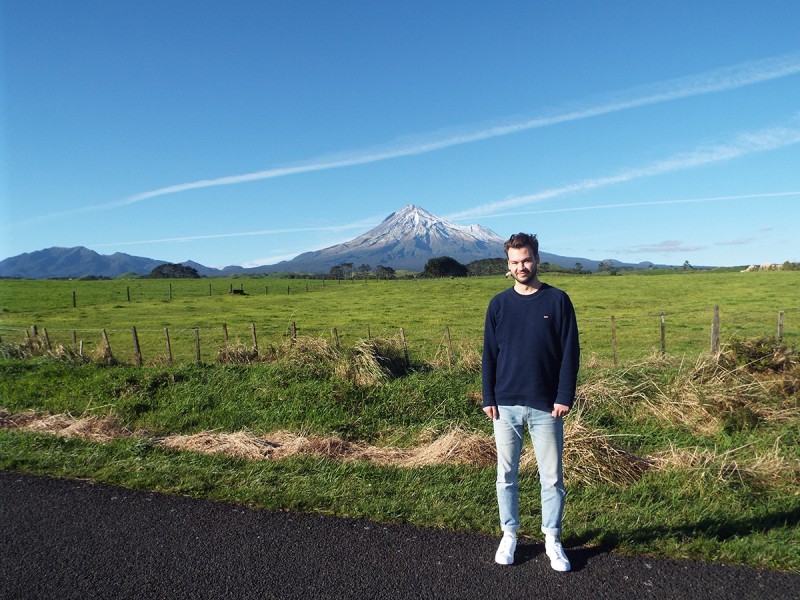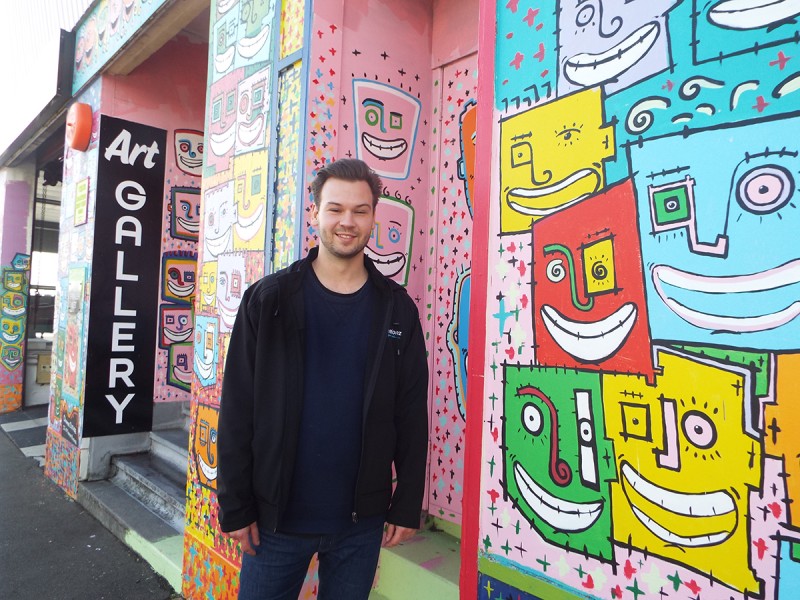
Mount Taranaki

Gover St Gallery
Len Lye Centre
Tawhiti Museum
Chaddy's Charters
Coastal Walkway
Pukekura Park
Hillsborough Holden Museum
The colours of the coast by Sam Hollis
Taranaki (Winter 2021)
Sure, I’ve spent a couple of nights in Taranaki before, stopped for lunch and quickly browsed a few shops in central New Plymouth, but what is this place really about? Is it the coastal culture, the immense Māori and European heritage, the quality experiences, the colourful art plastering the walls? You can probably see where this is going… On a sunny Friday morning, my partner Alex and I set about the five-and-a-half-hour drive from Wellington for four days of discovery, although we quickly realised that wouldn’t nearly be enough.
Along the way we stopped in at Aotea Utanganui, Museum of South Taranaki, in Pātea. Greeted by an arch of whakairo (carvings) specific to the region, this would set the tone for our journey through the many stories of Taranaki – intriguing at a glance, magnificent beneath the surface. We were guided by technical archivist Amber Wright and team leader Luana Paamu, who described the museum as being “like Te Papa on a Pātea budget”. The museum’s Hero Collection includes some of the earliest known wooden artifacts in New Zealand, such as a kumete (bowl) and a haumi (bow cover) from the 1400s. We stumbled across fascinating display after fascinating display as we roamed the floor: there’s the first-ever sketch map of the coast from Whanganui to Manawapou, illustrated in 1865; the story of the Pātea Māori Club, which produced perhaps the most iconic Kiwi song of all, Poi E; two 1935 carvings by Hēnare Toka; and even a small theatre showing the 2011 docudrama Waitangi: What Really Happened.
Sceptical of how the skies would behave in the coming days, we took advantage of the sunshine with a quick stroll around the Coastal Walkway as we arrived in New Plymouth. Little did we know, we’d walked right past our accommodation – Belt Road Seaside Holiday Park. Our unit, just a few minutes from the centre of New Plymouth and mere steps from the coastline, was cosy, scenic, and ideally located.
After a quick but delicious breakfast at Monica’s Eatery the next morning, we slipped next door to the Len Lye Centre to begin our designated ‘Art Day’. Before we saw any sculptures, we saw the building itself, impossible to miss as its wavy, mirror-clad exterior reflects light from every direction. Built in 2015 to join forces with the Govett-Brewster Art Gallery, the centre honours the life, work, and legacy of Len Lye, known for his kinetic sculptures and experimental films. I’ll be honest, I’d seen the Water Whirler on Wellington’s waterfront, and now the Wind Wand on New Plymouth’s coast… What’s the big deal? Well, after an hour and a half touring the centre with Jacqui, it’s fair to say I had been converted.
We’d arrived at the right time. In March, a new installation, Wand Dance, made its debut. The first instalment of the Len Lye Foundation’s planned series of large works adapted from the detailed blueprints Len Lye left behind, it consists of seven seemingly ubiquitous poles upon podiums, each with bells at the top. As we watched, the wands began to vibrate and sway, more and more violently as time passed, and the bells echoed intensely throughout the dark space. It was an utterly transfixing experience. Once we were told about its designer’s affinity for Indigenous art, it all made sense. Jacqui told us that Len Lye made a conscious decision to refute influence from Western art, going so far as to sleep with African artworks under his pillow in the hope it would help tap into his “primal brain”. This was exemplified throughout the next gallery, housing Tangibles: 1963-1969. This included the mesmerising Universe, made up of an enormous steel ring bouncing to connect with a suspended ball, and the intensely erotic Storm King. I’ll let your imagination fill in the blanks.
Next it was time to show some love to the dealer galleries of New Plymouth, which are easy to stumble across on a quick walk through the city. First up was Kina NZ Design + Artspace, chock-full of quirk in the form of jewellery, sculptures, prints, paintings, and more. Not far away we found Koru on Devon, the second Taranaki gallery established by renowned photographer Fay Looney. Featuring about 80 percent Kiwi artists, this was another example of the breadth of talent that can be found right on our doorstep. Simon Kerr’s angular, abstract paintings struck me more than anything else, and my interest was piqued when Fay told us that he began his craft while interned at Mount Eden Prison. Speaking of, the Gover Street Gallery, our next stop, just so happened to have the aptly titled Abstract Exhibition underway, featuring the work of Craig Novac, Ian Axtell, and Brett Williams, among many others. While each gallery has a wide variety, owner Heidi Griffin explained that hers focuses on work from Taranaki. There is no selection process, and artists as young as four have displayed work here.
Our final attraction for the day would require a trip to Hāwera. While we knew the Tawhiti Museum would be worth it, we weren’t prepared to be quite so awestruck. The brainchild of artist Nigel Ogle, it uses life-size exhibits and scale models to tell stories past. These fascinating stories took us through inciting events that birthed Taranaki as we know it today, from the British troops who arrived and conflicted with native Māori to the musket wars of the 1820s, the land wars of the 1860s, and beyond. We were mind blown by the fact that one artist did all this in his spare time, and with such precision and attention to detail. As if that wasn’t enough, Nigel then led us to Traders & Whalers. This part of the museum focuses on the history of the Taranaki Coast as a trading point and whaling spot for Māori and Europeans. The highlight for both of us, unsurprisingly, was an incredibly immersive boat ride that slowly transported us back 200 years with life-size exhibits and the sounds of nature and crossfire, illuminated ominously by dim lanterns and candlelight.
The next morning, with the weather unexpectedly pleasant, we jumped at the chance to get a close look at Port Taranaki and Ngā Motu (Sugar Loaf Islands) with Chaddy’s Charters, especially since we’d spent the previous afternoon hearing all about their history! With Carl Hayman as our skipper (yes, the former All Black), we boarded Rescue III. The wind treated us to a rocky ride. Still, the stories we heard were more than enough to distract us, especially the arrival of Dicky Barrett, one of the first European traders who called New Zealand home, who we’d first learned about at the Tawhiti Museum the day prior. What fascinated me was that people once managed to inhabit and live off the islands. They were also used to protect women and children during times of conflict, keeping them out of reach. With the sun shining as we returned to shore, we boarded our next vehicle of choice – e-bikes – and set out to take in the coastal walkway, culminating at Te Rewa Rewa Bridge.
Our afternoon was our own, and we were looking forward to a quiet drive around the towns of Taranaki. Although, I couldn’t help but call in at Vinyl Countdown, a renowned record store back on Devon Street, before hitting the road. We drove through Inglewood, Stratford, and pulled over in the surf town of Ōpunake. My eyes were drawn to Everybody’s Theatre, only natural considering the murals of Charlie Chaplin, Marilyn Monroe, John Wayne, and Jaws gracing its façade. We squeezed in a quick walk to look out over the cliffs of Ōpunake Beach, a picture equal in quality to those shown at the cinema.
Well, the clouds had been good to us, and as Monday rolled around they simply couldn’t keep doing us favours. However, the rainfall didn’t deter us from visiting Pukekura Park. Despite our clothes weighing twice as much by the time we got back to the car, we made time to cross the main lake via Poet’s Bridge and check out the famous Brooklands Bowl stage before warming up with coffees at the Tea House on the Lake. Even on a rainy day, it was clear why this is considered one of Aotearoa’s premier botanical gardens.
We’d certainly had our history fix, but as a bit of a petrolhead, the Hillsborough Holden Museum was a must as we began our journey back to Wellington. Similar to the Tawhiti Museum, this is the passion project of Inglewood-born Holden fanatic Steve Fabish. It boasts the largest private collection of Holden cars and memorabilia in the country, complete with Bathurst-themed minigolf and soon a restaurant and luge track. Steve has been collecting for roughly 25 years, but got his very first Holden in 1972. There are now 47 vehicles on display, ranging from the late 1940s to 2016 with incredibly rare acquisitions amongst them. Given General Motors sadly announced the retirement of Holden last year, this was a beautiful trip down memory lane, and hearing it all from a true fan like Steve made it all the more memorable.
Even over a weekend with questionable weather, Taranaki put on a show for Alex and me. Amongst the variety of attractions we visited, what surprised me was the dense heritage on display, shared by passionate locals who simply can’t get enough of their town. For every spot we checked out, there was another we didn’t have time for. I guess we’ll be back on the road to Taranaki soon.
View more articles:
« Back to 'Travel Experiences'
